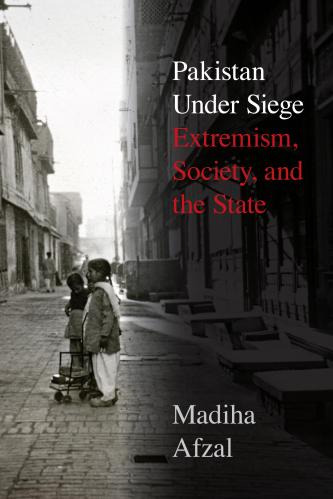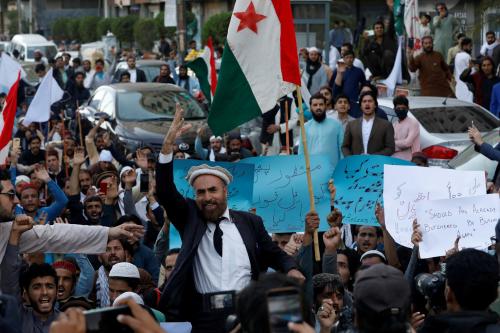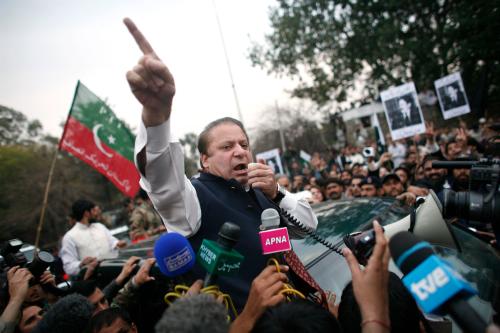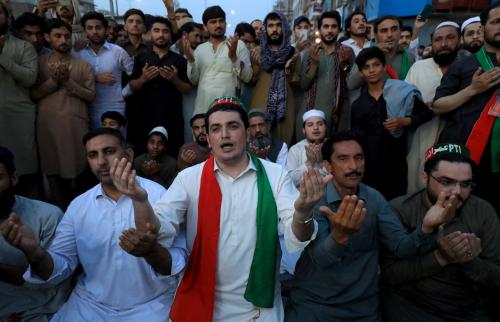On May 12, Dawn, Pakistan’s oldest and most prestigious English daily, published an interview with former Prime Minister Nawaz Sharif, in which Sharif uttered four relatively oblique sentences: “Militant organizations are active. Call them non-state actors, should we allow them to cross the border and kill 150 people in Mumbai? Explain it to me. Why can’t we complete the trial?” He was referring, ostensibly, to Lashkar-e-Taiba’s involvement in the 2008 Mumbai attack. Lashkar and its leader, Hafiz Saeed, have not been held accountable, and the trial has stalled in an anti-terrorism court in Pakistan.
The alleged connections between Pakistan’s intelligence agencies and militant non-state actors that target India such as the Lashkar-e-Taiba are well known outside Pakistan, but less understood within the country—deliberately so, since this serves to maintain the perception of the army’s moral supremacy.
Sharif’s interview created an instant furor in Pakistan. Many Pakistanis are skeptical of his motives as he fights for his political survival after being disqualified as prime minister by the Supreme Court last year on corruption-related charges. Sharif says the charges against him are politically motivated, and suggests they were pursued by a military that disliked his independence. He is punching back whenever he can.
Blocking coverage of non-state militants
After the Dawn interview was published, the Pakistan Press Council served the newspaper’s editor with a notice that it breached the council’s code of conduct by publishing content that “may bring into contempt Pakistan or its people or tends to undermine its sovereignty or integrity as an independent country.” Distribution of the newspaper was subsequently blocked in parts of the country.
No one doubts the military’s involvement in this censorship. It is the latest example of a steadily accumulating set of suppressive measures it seems to be taking against the media in recent months, to various ends: to control its own narrative and maintain its hold on the country, to control Pakistan’s global image, to weaken Sharif, and to try to meddle in the upcoming general election this July.
Both Pakistan’s military and its civilian government want to project the image of a country that has successfully tackled its security issues. The military has given tours of a cleaned-up Waziristan, which had been off-limits to the media during the army operation against the Pakistan Taliban in that area. Its ministers and ambassadors give a standard spiel abroad that touts Pakistan’s successes against domestic terrorism and the Pakistan Taliban—especially in the wake of criticism from the Trump administration—deflecting away from connections with the Lashkar-e-Taiba and the Afghan Taliban. It is true that the number of terrorist attacks in Pakistan has decreased drastically in recent years, as have deaths as a result of violence. But terrorism continues at a lower tick, and extremism thrives, as attested to by the street power of the fundamentalist group Tehreek-e-Labaik, whose signature concern is the preservation of Pakistan’s regressive blasphemy laws.
Blocking coverage of an ethnic rights movement
But groups like that don’t bother the military (it refused to take physical action against Tehreek-e-Labaik protesters in December 2017, and handed out money to them when the protest disbanded). The biggest thorn in the military’s side right now, other than Sharif, is the Pashtun Tahaffuz Movement (or PTM; Tahaffuz means protection). The movement alleges widespread human rights abuses by the military, including forced disappearances and extrajudicial killings, during the army operations against the Pakistan Taliban in the country’s northwest in the last decade. It has led fiery rallies across the country and in Pakistan’s urban centers, with a charismatic 24 year-old, Manzoor Pashteen, at the helm.
Coverage of the movement is all but blacked out in the Pakistani media. That is not surprising, since they make some quite shocking claims: that the military is connected to the (Pakistan) Taliban—even going further and saying they are one and the same—and that under cover of the military operation, the military shuffled the Taliban to Afghanistan.
I had heard this exact narrative and rhetoric from a group of Pashtun students at a university in Lahore three years ago, in 2015, while I was conducting focus group interviews for my book. My discussion with these students had lasted for hours—and I came away surprised and with a deeper understanding of Pakistan itself. My interviewees were intensely critical of the army and angry over what Pakistan’s northwest and tribal areas were going through. They questioned Pakistan’s religious ideology, something I had not heard much of elsewhere. They noted that their views would have them branded as traitors. But their most stunning remarks came when I asked them who was conducting terrorism in Pakistan. They linked the army to the attack that killed more than 130 schoolchildren at the Peshawar Army Public School in December 2014. They were skeptical of the Zarb-e-Azb military operation, arguing that the media blackout was covering up collusion with the Taliban.
In my book, I noted that these students’ nonconformist views on the Pakistan narrative were refreshing to hear; but on the connections between the army and the Pakistan Taliban—which had attacked so much of the army itself—they seemed conspiratorial. Nevertheless, it was a significant perspective that I hadn’t heard before, and I only heard it again when the Pashtun Tahaffuz Movement went mainstream this year.
Because the state has banned coverage of the movement, most Pakistanis don’t know about, or understand, the grievances of other ethnicities against the state—similar to a media blackout of the insurgency in the restive province of Baluchistan. Prominent op-ed writers, for the first time in many years of writing for the same newspapers, have seen their columns on the PTM pulled; in turn, their write-ups about crackdowns on media freedom are also being censored. This means that a proper, national conversation cannot be had about these issues. The movement is being discussed on social media, where you see two echo chambers: those against the movement, and those supportive of it. In the absence of open coverage, there is no political discussion about the military’s alleged abuses—nor questions raised by PTM enthusiasts about what the movement gets wrong about the army’s connections to the Pakistan Taliban versus the Afghan Taliban, or where its rhetoric peddles in conspiracies. Nor, in this blackout, can Pakistanis understand how many terrorists were actually in the mix in the cleanup undertaken by the Pakistani state in the tribal areas. The PTM demands a truth and reconciliation commission. The state owes it that, but before that, it owes the movement, and all Pakistanis, an open national conversation.
Censored—to what end?
Pakistan’s military believes it can clamp down on dissent via censorship—and continue to control the image and identity of the country as it has defined it, as an Islamic state under threat from India. Ethnic grievances and military abuses brought to light by the PTM, and Sharif’s discussion of non-state actors targeting India (thus implicating Pakistan in aggression against India), threaten the state-cultivated image of the country and sully the military. So, it keeps them under wraps.
The military’s censorship is selective—not blanket, à la Erdoğan in Turkey—which gives it plausible deniability. While coverage of the PTM is blacked out, its rallies have been allowed to continue. Not all journalists and bloggers critical of the military are disappeared or threatened—but some are, enough to have a chilling effect and to lead to self-censorship. Television channels critical of the military are taken off air, or given a lower rung on the lineup.
To what end? Given the existence of social media, the military only comes in for more criticism internationally. But in the country, it succeeds in controlling its image. And so it continues. Yet it has chilled the national debate and discussion, and only alienated those already marginalized. Pakistan needs only to look to 1971, when its eastern half seceded to form Bangladesh, to see the potentially disastrous effects of such ethnic and political alienation. The right approach to its own citizens and to criticism is clear: engagement, not censorship.
The Brookings Institution is committed to quality, independence, and impact.
We are supported by a diverse array of funders. In line with our values and policies, each Brookings publication represents the sole views of its author(s).








Commentary
Pakistan’s censorship model
An image- and identity-obsessed country
May 30, 2018